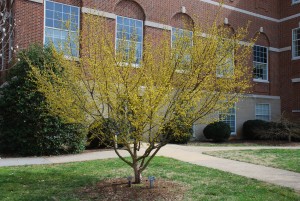Cornelian cherry (Cornus mas) is a multi-stemmed, low-branched dogwood tree or shrub. It typically grows 20-25 feet tall and slightly less in overall width (USDA hardiness zones 4-7). Tiny, golden yellow flowers appear in late winter, around March 1st in my east Tennessee garden, and remain in bloom through most of the month despite cold winter nights and snow.
Leavess emerge around the first day of spring. Small drupe fruits (called “cornels”) ripen in late summer, and are tasty morsels for birds. Most of the fruits may stay hidden inside the dense foliage until late fall. In eastern Europe, where Cornelian cherry is native, the sour tasting fruits are made into syrups or jams.
In the autumn the dark green oval-shaped leaves turn a dull purple tinge before dropping. No serious insect or pests bother Cornelian cherry, and surprisingly, deer don’t seem to relish either foliage or fruits. A prominent feature on this long lived tree/shrub is its flakey gray-brown bark which exfoliates over the main trunk(s) and older branches as it ages.
Branching tends to be upright and is easily trained into a small single-trunked tree by clearing away all suckers around the base. Plant it in well-drained, slightly acidic soil, and in full to partial sunlight (6-hours minimum). Cornelian cherry makes a fine specimen tree or utilize as a deciduous hedge or privacy screen.
Among plant nerds it has been long debated whether Japanese cornel (C. officinalis) is prettier in bloom than Cornelian cherry. My suggestion is to plant both! ‘Golden Glory’ and ‘Spring Glow’ are major cultivars sold at many garden centers. ‘Aurea’ is a golden yellow leaf form available from on-line nursery sources. Reportedly, ‘Spring Glow’ produces very few fruits annually.


 Posted in
Posted in 
